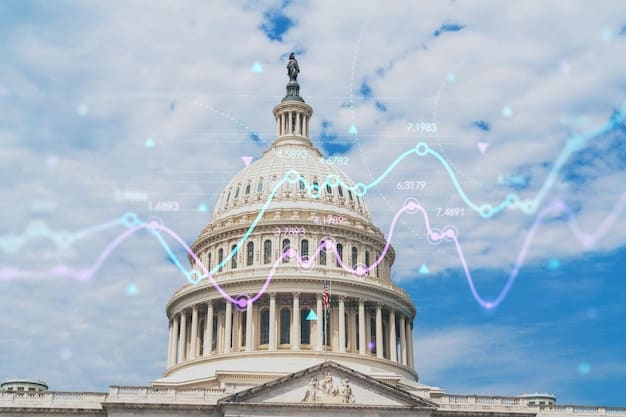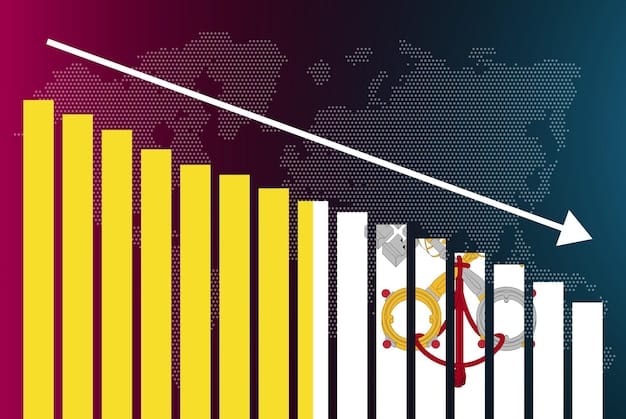Understanding the Impact of GDP Updates on the US Economy

The Impact of the Updated Gross Domestic Product (GDP) Figures on the US Economy is significant, influencing investment decisions, monetary policy, and overall economic forecasting, providing a crucial snapshot of economic health and performance.
The Impact of the Updated Gross Domestic Product (GDP) Figures on the US Economy is a topic of considerable interest to economists, investors, and policymakers alike. Understanding these updates and their implications is crucial for navigating the complex economic landscape. Let’s delve into the specifics and shed light on how these figures shape our economic outlook.
Understanding Gross Domestic Product (GDP)
Gross Domestic Product (GDP) is the total monetary or market value of all the finished goods and services produced within a country’s borders in a specific time period. It serves as a comprehensive scorecard of a country’s economic health, reflecting the size and growth rate of the economy.
What GDP Measures
GDP measures several key components of economic activity, including:
- Consumer Spending: Represents the expenditures by households on goods and services.
- Investment: Includes business investments in capital goods, residential construction, and changes in inventories.
- Government Spending: Covers government expenditures on goods and services, including infrastructure, defense, and public services.
- Net Exports: The difference between a country’s exports and imports, reflecting its trade balance.
Nominal vs. Real GDP
GDP can be expressed in two forms: nominal and real. Nominal GDP measures the value of goods and services at current prices, without adjusting for inflation. Real GDP, on the other hand, adjusts for inflation, providing a more accurate measure of economic growth by reflecting the volume of goods and services produced.

Understanding the distinction between nominal and real GDP is crucial for assessing true economic performance. Real GDP is often favored by economists because it provides a clearer picture of economic growth by eliminating the effects of price changes.
In conclusion, GDP is a fundamental indicator that provides a comprehensive view of economic activity within a country. By measuring consumer spending, investment, government spending, and net exports, GDP offers insights into the overall health and performance of the economy.
The Significance of GDP Updates
GDP figures are not static; they are subject to revisions and updates as new data becomes available. These updates are crucial because they can significantly alter our understanding of the economy’s past performance and future trajectory.
Why GDP Figures Are Updated
GDP figures are updated for several reasons:
- Availability of New Data: Initial GDP estimates are often based on incomplete data. As more comprehensive data becomes available, the figures are revised to reflect this new information.
- Benchmarking Revisions: Periodically, comprehensive benchmarking revisions are conducted to incorporate new data sources, improved methodologies, and changes in definitions and classifications.
- Seasonal Adjustments: GDP figures are seasonally adjusted to remove the effects of predictable seasonal patterns, such as increased consumer spending during the holiday season.
Impact of Revisions
GDP revisions can have a notable impact on economic analysis and policymaking. Substantial revisions can lead to:
Economic policies are often based on GDP figures. Significant revisions can prompt policymakers to reassess their strategies and make adjustments to fiscal and monetary policies accordingly.
GDP updates can confirm or challenge previous economic assessments, providing a more accurate reflection of economic health.
In summary, GDP updates are a vital part of economic measurement, providing a more accurate and complete picture of economic activity. These revisions can have significant implications for economic analysis, policymaking, and market reactions.
How GDP Updates Affect Economic Forecasting
Economic forecasting relies heavily on historical GDP data to predict future economic trends. Therefore, updates to GDP figures can significantly impact the accuracy and reliability of these forecasts.

The Role of Historical Data
Historical GDP data is used to identify patterns and trends in economic growth. These patterns are then used to build economic models that forecast future GDP growth. Updates to historical GDP data can change these patterns and lead to revisions in economic forecasts.
Impact on Forecast Accuracy
The accuracy of economic forecasts depends on the quality and reliability of the underlying data. GDP updates can improve the accuracy of forecasts by providing a more precise understanding of past economic performance. However, significant revisions can also introduce uncertainty and make forecasting more challenging.
GDP updates can change the outlook for economic growth, inflation, and employment. These changes can affect investment decisions, business planning, and consumer behavior. Accurate forecasts are essential for mitigating risk and making informed decisions.
To conclude, GDP updates play a crucial role in economic forecasting, influencing the accuracy and reliability of predictions about future economic trends. These updates can impact investment decisions, business planning, and consumer behavior, highlighting the importance of staying informed about revisions to GDP figures.
The Influence of GDP Updates on Investment Decisions
Investment decisions are heavily influenced by economic indicators, with GDP being a key metric. Updates to GDP figures can, therefore, trigger significant shifts in investment strategies and market sentiment.
Investor Confidence
Positive GDP revisions can boost investor confidence, leading to increased investment in stocks, bonds, and other assets. Conversely, negative revisions can dampen investor sentiment and trigger a flight to safety.
Sector-Specific Impacts
GDP updates can have different impacts on different sectors of the economy. For example, upward revisions to GDP growth may benefit cyclical sectors such as manufacturing and consumer discretionary, while downward revisions may disproportionately affect sectors sensitive to economic slowdowns.
GDP revisions can influence asset allocation decisions, with investors shifting their portfolios to take advantage of perceived opportunities or mitigate potential risks. For instance, stronger GDP growth may lead investors to increase their exposure to equities, while weaker growth may prompt them to allocate more to fixed income.
In conclusion, GDP updates play a pivotal role in shaping investment decisions, influencing investor confidence, sector-specific impacts, and asset allocation strategies. Staying abreast of these revisions is essential for investors seeking to make informed decisions and optimize their portfolios.
GDP Updates and Monetary Policy
Central banks, such as the Federal Reserve (Fed) in the United States, closely monitor GDP figures when formulating monetary policy. Updates to GDP can influence the Fed’s decisions regarding interest rates, quantitative easing, and other policy tools.
Interest Rate Adjustments
Strong GDP growth may prompt the Fed to raise interest rates to prevent inflation and promote sustainable economic expansion. Conversely, weak GDP growth may lead the Fed to lower interest rates to stimulate economic activity.
Quantitative Easing
In times of economic distress, the Fed may implement quantitative easing (QE) programs to inject liquidity into the financial system and support economic growth. GDP updates can influence the scale and duration of QE programs.
GDP revisions can impact the Fed’s assessment of inflation risks. Higher GDP growth may lead to increased inflationary pressures, prompting the Fed to tighten monetary policy. Conversely, lower GDP growth may reduce inflationary pressures, giving the Fed more room to maintain accommodative policies.
In summary, GDP updates are a critical input in the formulation of monetary policy, influencing decisions regarding interest rates, quantitative easing, and inflation targeting. Central banks rely on accurate and timely GDP data to steer the economy towards price stability and full employment.
The Role of Government Agencies in Collecting and Reporting GDP Data
Government agencies play a crucial role in collecting, compiling, and reporting GDP data. In the United States, the Bureau of Economic Analysis (BEA) is responsible for producing GDP estimates.
Data Collection Methods
The BEA uses a variety of data sources to estimate GDP, including:
- Surveys of Businesses: Collect data on sales, production, and inventories.
- Government Administrative Data: Utilizes tax records, employment data, and other administrative records.
- Census Data: Gathers information on population, housing, and economic activity.
Reporting Frequency
The BEA releases GDP estimates on a quarterly basis, with preliminary, second, and final estimates for each quarter. These estimates are subject to revisions as more data becomes available.
The BEA strives to ensure the accuracy and reliability of GDP data by employing rigorous statistical methods and adhering to international standards. Revisions to GDP estimates are carefully documented and explained to provide transparency and clarity.
Ultimately, government agencies like the BEA are essential for producing high-quality GDP data that informs economic analysis, policymaking, and business decisions. These agencies play a vital role in providing insights into economic performance and fostering a better understanding of the economy.
| Key Aspects | Brief Description |
|---|---|
| 📈 GDP Measurement | GDP calculates total economic output within a country’s borders. |
| 🔄 GDP Updates | Figures are revised as new data emerges, impacting analysis. |
| 💰 Investment Impact | Updates influence investor confidence and asset allocation. |
| 🏦 Policy Influence | Central banks use updates to adjust monetary policy. |
Frequently Asked Questions (FAQ)
▼
GDP’s main purpose is to measure the total value of goods and services produced within a country’s borders during a specific period, providing a snapshot of economic health and growth.
▼
GDP figures are revised as new, more comprehensive data becomes available. These revisions provide a more accurate representation of past economic performance.
▼
GDP updates can influence investor sentiment and decisions. Positive revisions might boost confidence, while negative ones might lead to caution or shifts in investment strategies.
▼
Government agencies like the BEA collect, compile, and report GDP data. They ensure data accuracy using surveys, administrative records, and rigorous statistical methods.
▼
Central banks, such as the Federal Reserve, monitor GDP figures to make informed decisions on monetary policy, adjusting interest rates and other policy tools accordingly.
Conclusion
In conclusion, understanding the Impact of the Updated Gross Domestic Product (GDP) Figures on the US Economy is crucial for investors, policymakers, and anyone interested in economic trends. By staying informed about GDP revisions and their implications, stakeholders can make better decisions and contribute to a more stable and prosperous economy.





